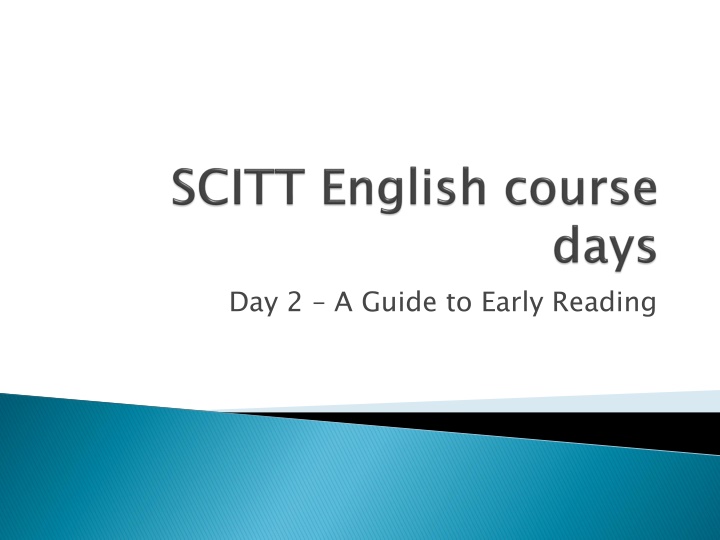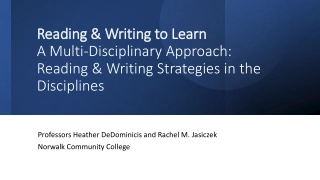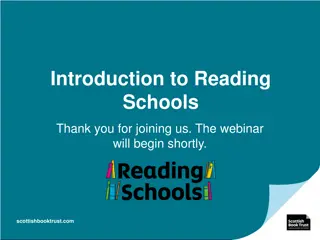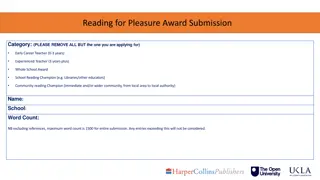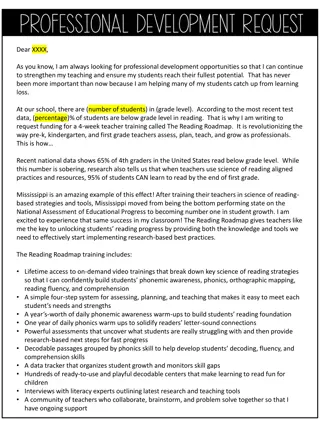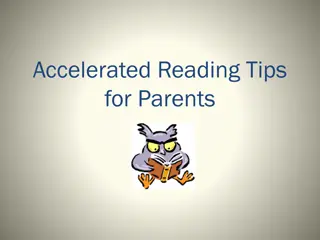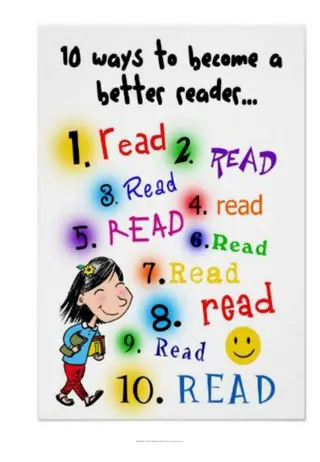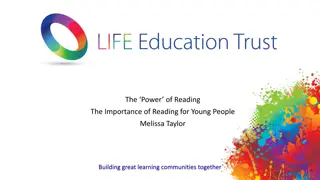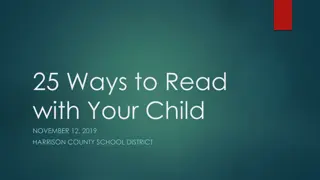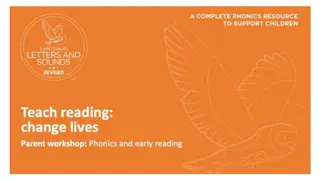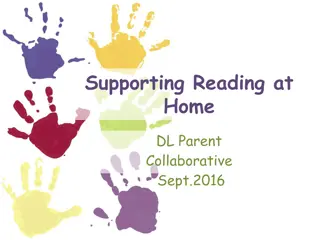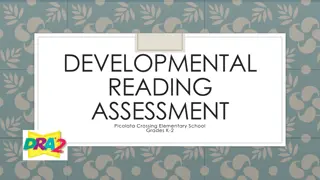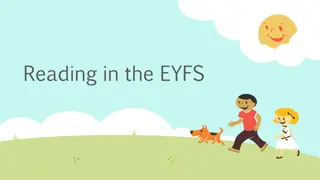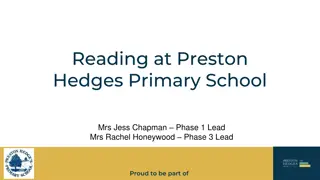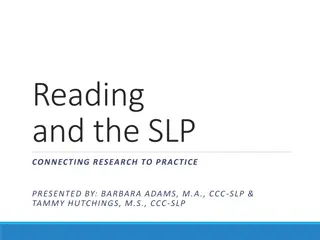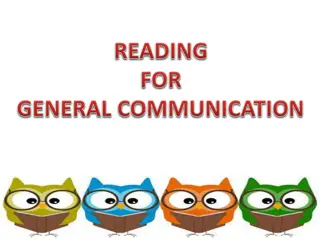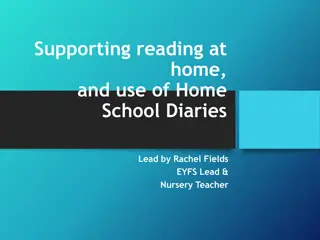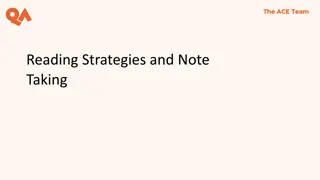Unlocking Early Reading Success: A Comprehensive Guide
Discover the key factors in teaching early reading, including organizing English instruction, developing phonics skills, and enhancing word recognition. Explore strategies for supporting young readers and improving language comprehension to foster a strong foundation in literacy.
Uploaded on Sep 12, 2024 | 0 Views
Download Presentation

Please find below an Image/Link to download the presentation.
The content on the website is provided AS IS for your information and personal use only. It may not be sold, licensed, or shared on other websites without obtaining consent from the author.If you encounter any issues during the download, it is possible that the publisher has removed the file from their server.
You are allowed to download the files provided on this website for personal or commercial use, subject to the condition that they are used lawfully. All files are the property of their respective owners.
The content on the website is provided AS IS for your information and personal use only. It may not be sold, licensed, or shared on other websites without obtaining consent from the author.
E N D
Presentation Transcript
Find out how your school organises the teaching of English. Write a reflective log giving your thoughts and explaining why English is organised in this way. How did your school transform and connect subject knowledge?
Practice is a noun Practise is a verb Try using the lessons trick He went to the medical .............. You ll get better with .............. You ll need to ............. a lot more. Jim was ..............ing on his flute.
You will understand How children become readers How early reading develops How phonics works How to plan and teach a phonics session
Graudle Thoted Kerming
G O O D Word Recognition POOR GOOD P O O R Language comprehension
Good word recognition, good language comprehension Good language comprehension, poor word recognition G O O D Word Recognition POOR GOOD Poor word recognition, poor language comprehension Good word recognition, poor language comprehension P O O R Language comprehension
Phonics - sounds and spelling Knowledge of context TEXT Grammatical knowledge Word recognition and graphic knowledge
Which strategies would an early reader use to tackle the boxed words?
There is a risk, and one fuelled by recent coverage of the Clackmannanshire study, that phonics is somehow seen as a magic bullet which will ensure that every child leaves primary school as an effective and enthusiastic reader We promote phonics as the first and foremost strategy that children employ as they encounter new words. But on its own it simply is not enough. 2005) But on its own it simply is not enough. Ruth Kelly in The Guardian (5 April,
It is a myth that our language is so irregular that phonics is not enough . is a complicated language with its spelling variations and pronunciation variations. This is all the more reason to teach phonics rigorously and systematically from the outset as children are empowered to tackle their complex language so much more efficiently. The process of blending is simple enough and does not vary, but the ideas of tweaking the pronunciation and examining the irregular parts need to be taught. It is a myth that our language is so irregular that phonics is not enough . We do have a phonic language although it Debbie Hepplewhite
A phoneme is the smallest unit of sound in a word b-a-t, sh-e-d and ch-ee-se all contain three phonemes Play phoneme count. How many phonemes in each word?
Shop Cat __ . . . . . Daughter Bridge . ______ . __ . . . ___
Visual representation of the relationship between the 44 phonemes (sounds) of spoken English and the 26 letters of the alphabet It is about where sounds live You need good phonic awareness to choose the right box and then good visual awareness to choose the right grapheme http://34d2010.global2.vic.edu.au/files/2010/05/spellingfocus.jpg
The 44 phonemes are made up from: 24 consonant phonemes 20 vowel phonemes Mr Thorne does Phonics
graph digraph trigraph quadgraph graph - a 1 letter spelling choice digraph - a 2 letter spelling choice trigraph - a 3 letter spelling choice quadgraph - a 4 letter spelling choice
These Time Tone Cube Cave
What are you looking after on the chart? (initial letter of name) Work out now using all letters in your name http://www.thrass.co.uk/sitebuildercontent/sitebuilderpictures/English-Phonics-Chart-Large.jpg
Phonemes (sounds) are represented by letters (graphemes) Some of these graphemes are represented by more than one letter Some phonemes can be represented by different graphemes Some graphemes represent more than one phoneme Letters have names
Reading involves changing graphemes to phonemes. This is known as blending Spelling involves changing phonemes to graphemes. This is known as segmenting
Consonant clusters/blends represented by, for example i.two graphs, e.g. tr = t and r ii.digraph and graph, e.g. shr sh and r Consonant clusters/blends - - may be represented by, for example: may be
Which of these are CVC words bow stew try shock few weight hiss fish saw his chin
CCVC spell CVCC felt CCCVC strum CCVCC - drank
Hand Drag Sheep Height Witch Cream Spell Lamp Brick Cramp Stand
An approach to the teaching of reading in which the phonemes associated with particular graphemes are pronounced in isolation and blended together. Synthetic phonics for writing reverses the sequence: children are taught to say the word they wish to write, segment it into its phonemes and say them in turn.
An approach to the teaching of reading in which the phonemes associated with particular graphemes are not pronounced in isolation. Children identify the common phoneme in a set of words. Analytic phonics for writing similarly relies on inferential learning. Children deduce how to spell by comparing to other words that they know
Trying out different spelling choices Knowing the most common spelling choices Knowing where certain spelling choices are likely to occur in a word
List as many words as you can with the /ae/ sound in Group them under the different representations of the /ae/ sound Which are most common?
oi, oy (coin) or, ore, oor, aw (fork) er, ir, ur, or (fern) ow, ou (cow) a-e, ai, ay (baby) ea, ee, ey, y (me) i-e, igh, i, y (tiger) o, oa, o-e, oe, ow (nose) oo, u-e, ue, ew (moon)
Followed by consonant Followed by consonant Final Final ai, a-e ay ee, ea ee, ea, ey, y igh, i-e, i igh, y oa, o-e, o ow, o, oe oo, u-e ew, ue, oo oi oy or or, oor, ore ur, ir, er, or ur, ir, er ou, ow ow
Easy words are decodable high frequency words e.g. can, with, back, time Tricky words are non-decodable high frequency words e.g. go, they, have, people
Brisk pace of learning Systematic Ambitious Active participation by all Well planned Progress is monitored carefully Teaching is adapted to achieve optimum progress for each child Praise and reinforcement Applied outside phonic sessions Babcock LDP Phonics Play
Letters and Sounds Read Write Inc Jolly Phonics THRASS
Seven aspects General sound discrimination environmental sounds General sound discrimination Instrumental sounds General sound discrimination body percussion Rhythm and rhyme Alliteration Voice sounds Oral blending and segmenting Each divided into three strands Tuning into sounds (auditory discrimination) Listening and remembering (auditory memory) Talking about sounds (vocabulary and comprehension)
Up to six weeks long in YR Letter progression specified Timetable suggested Session sequence specified Children taught 19 graphemes and 1 sound for each Move from oral blending and segmenting to using letters (VC and beginning CVC) Begin to spell high-frequency tricky words e.g. the, to, no, go
1. s a t p 2. i n m d 3. g o c k 4. ck e u r 5. h b f ff l ll ss
